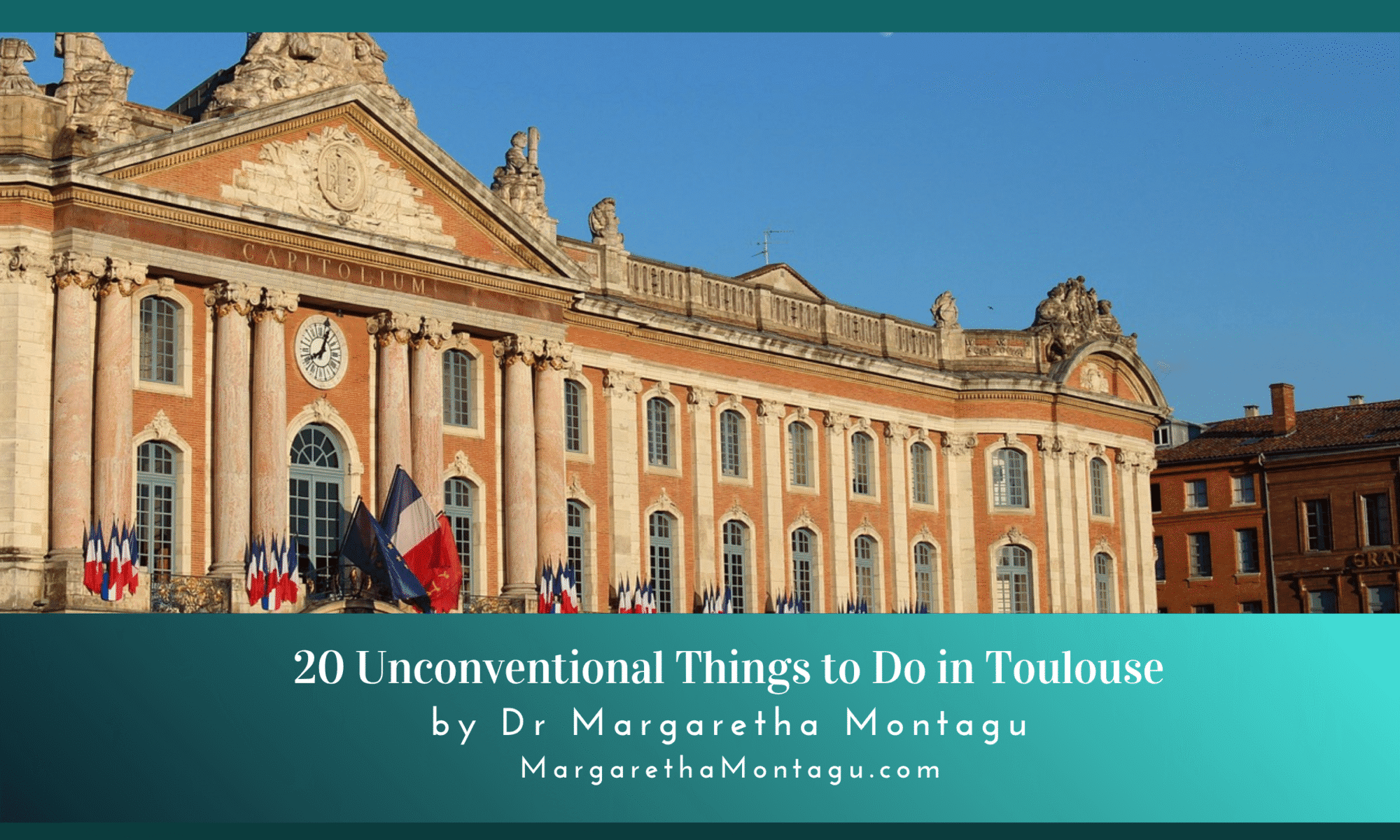For those passing through La Ville Rose on their way to my Camino de Santiago Crossroads retreats
Ecoute, I could tell you to visit the Basilique Saint-Sernin (spoiler: you absolutely should – it’s a must-see!). But if you’re not here for the obvious and you want to know where the real Toulouse lives, breathes, and occasionally drinks too much rosé on a Wednesday afternoon, I wrote this for you.
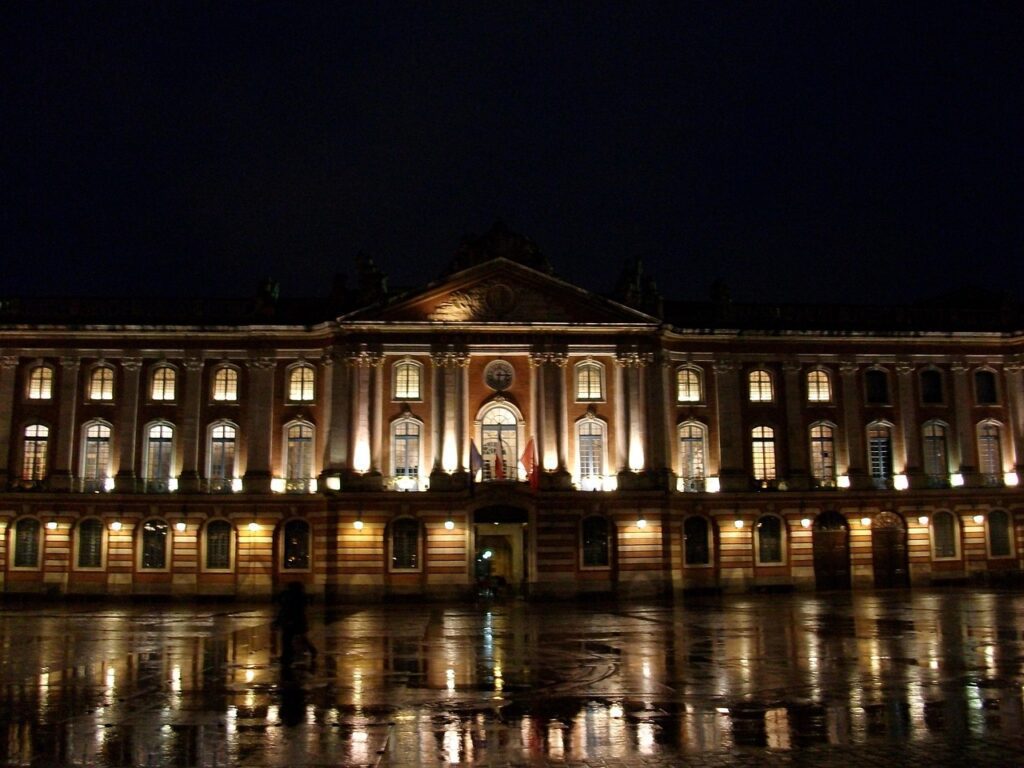
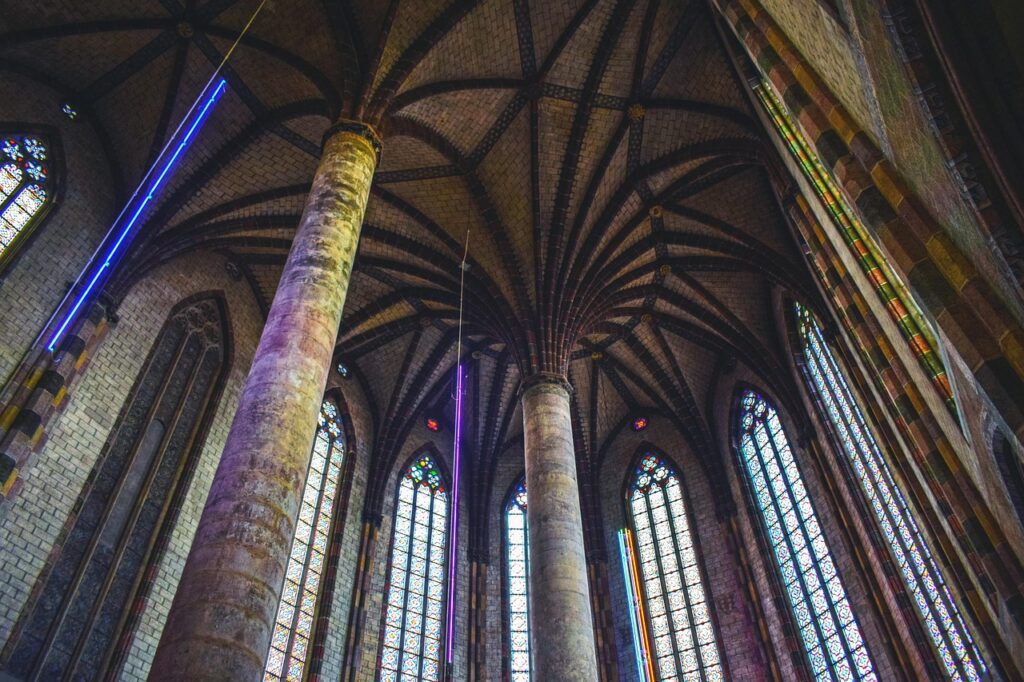
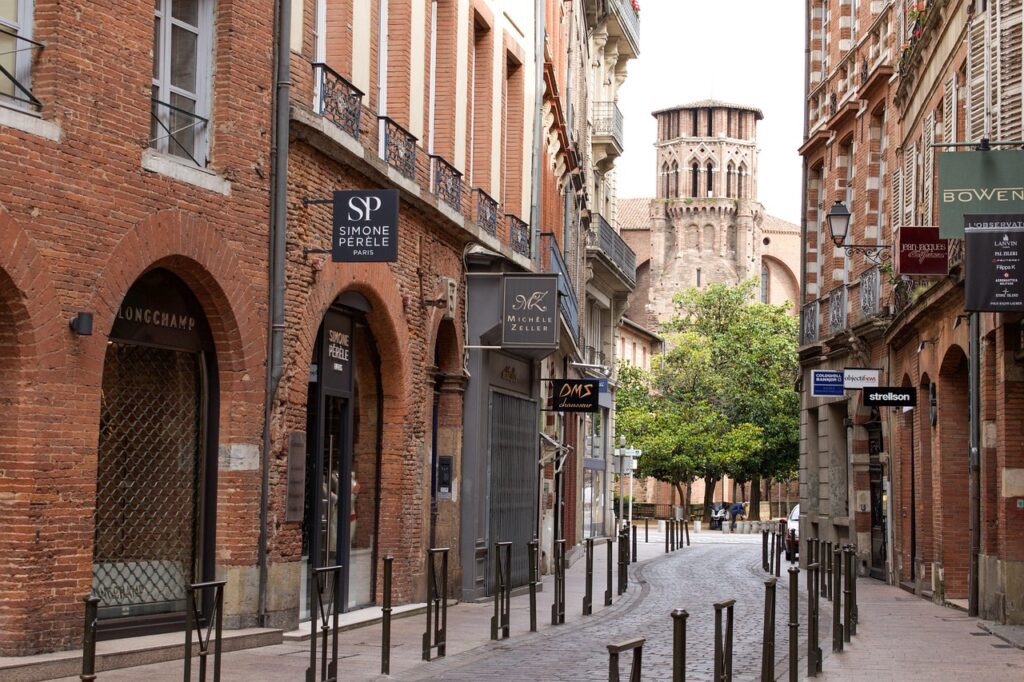
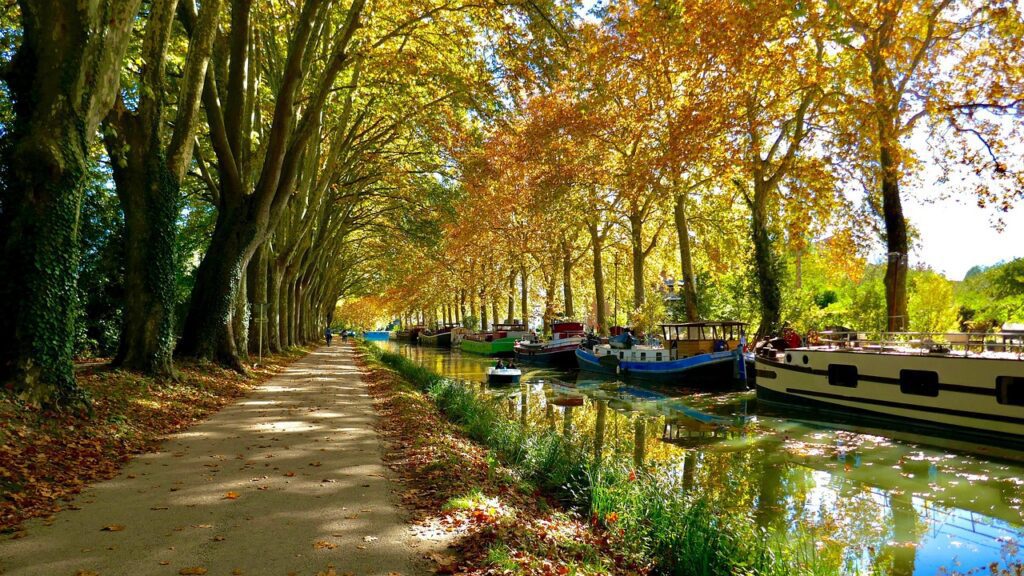
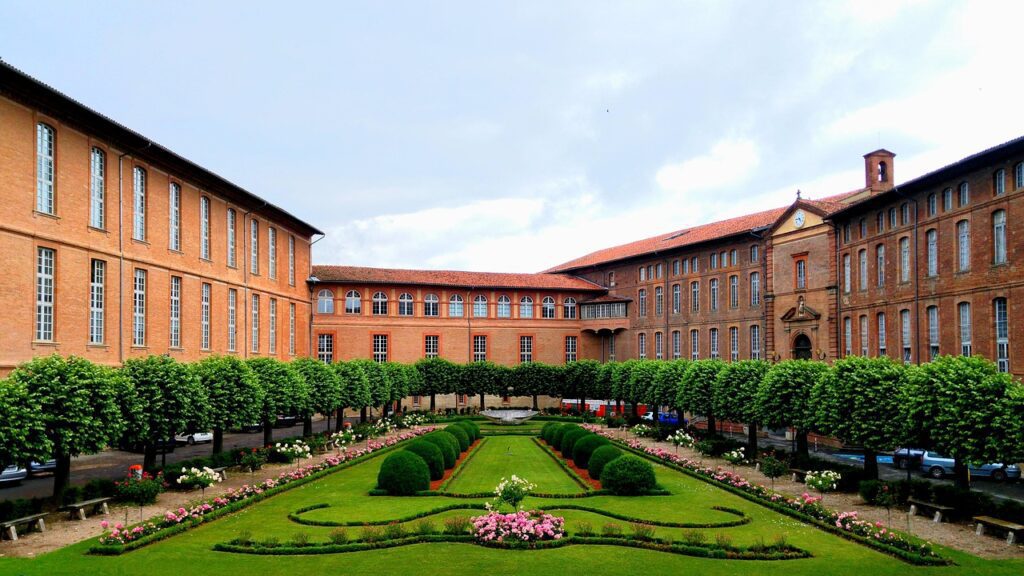
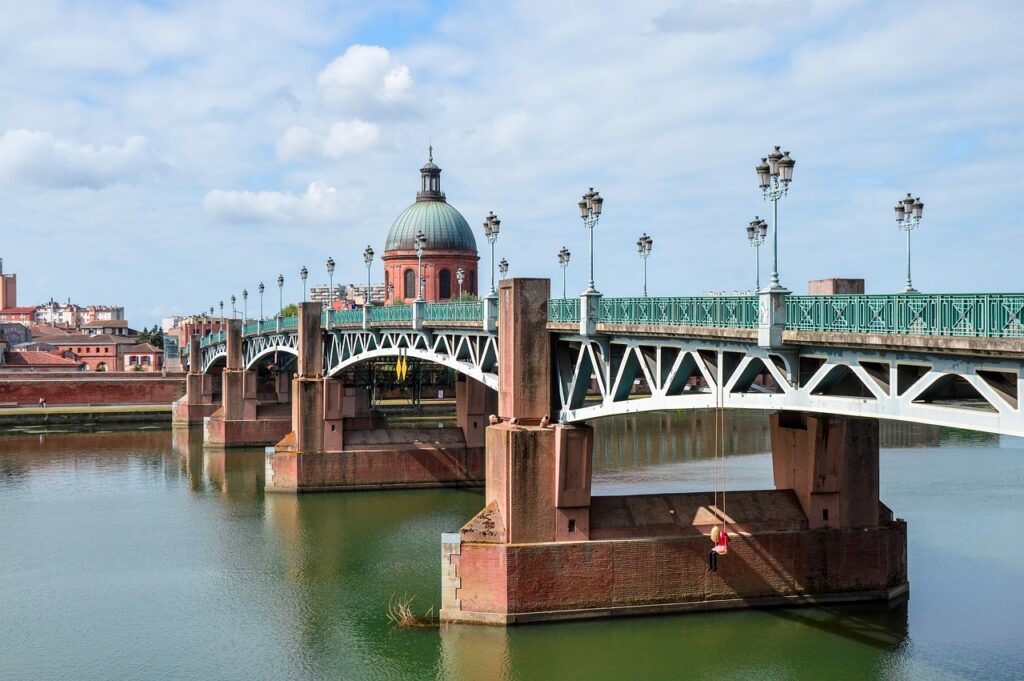
1. Ride a 47-ton mechanical Minotaur through the streets
At La Halle de la Machine, you can actually climb aboard Astérion, a 14-meter-tall wood-and-steel minotaur that gallops, rears up, and falls asleep. This isn’t some static museum piece – you’re literally riding a breathing (well, steam-breathing) mechanical beast through an industrial hangar that feels like Jules Verne’s fever dream.
The whole experience is utterly bonkers in the best way possible. You can book tickets online, and there’s even a Minotaure Café serving seasonal local dishes if beast-wrangling builds up your appetite. The creators are the same mad geniuses behind Nantes’ mechanical elephant, and they’ve brought their fantastical vision to Toulouse’s old industrial district. It’s located in the Montaudran Aerospace area, which means you’re in aerospace heaven if you’re into that sort of thing. But even if you’re not, watching families ride a mythological creature together is pure magic. Budget around €9-12 for the ride, and give yourself at least 90 minutes to explore the entire space. Pro tip: Go on a weekday if you can – weekends get packed with families, and you’ll want time to truly absorb the steampunk wonderland without being rushed.
2. Hunt for Space Invaders across the city
Street artists have left “Invaders” works throughout Toulouse – stickers and collages referencing the 1978 video game. This is the work of a French artist known simply as “Invader” who’s been “invading” cities worldwide since the late ’90s. Flash the QR codes with your phone using the official FlashInvaders app, and you’ll rack up points like you’re actually playing the game.
This is brilliant: it forces you to look up instead of at your phone (ironic, I know), and suddenly you’re noticing architectural details you’d have walked past. That gargoyle? The Art Nouveau ironwork? The hidden courtyard entrance? You’d have missed them all if you weren’t hunting pixels. The invaders are usually tucked into corners where two streets meet, above doorways, on bridge supports – anywhere the artist could climb with his tiles and adhesive. Some have been there for over a decade; others appear overnight. It’s a constantly evolving treasure hunt that makes you feel like you’re part of a secret club. Download the app before you arrive (it works offline), and make it a game with your travel companion. Winner buys drinks? Just saying. See Granhota
3. Decode the 24-hour clock on Rue Rivals
On the corner where Rue Rivals meets Rue Alsace-Lorraine, there’s a rare clock from 1895 with 24-hour markers instead of 12 – one of only two in France. Now, you might be thinking, “It’s just a clock.” But stick with me here.
This clock tells a story about Toulouse’s railway history and the city’s obsession with precision timekeeping when trains revolutionised travel. It was installed by a watchmaker who clearly thought the 12-hour system was for amateurs. The clock face is absolutely gorgeous – ornate, detailed, with that patina that only comes from 130 years of Toulouse weather. Stand there for a moment and imagine: this clock was already ticking when your great-great-grandparents might have walked this very street. The location is prime – right in the heart of the shopping district – so you can easily combine this with a coffee stop at one of the nearby cafés. Take a photo, set it as your phone background, and confuse everyone back home when they try to figure out what time it is. (“Is it 17 o’clock? What sorcery is this?”) It’s these tiny, quirky details that make a city unforgettable.
4. Discover the “child with a dunce cap” on Pont Neuf
A small red statue leans over the oldest bridge in Toulouse (ironically called “New Bridge”), looking like it’s pondering what’s in the Garonne. The bridge itself dates from the 16th century and took nearly a century to build – talk about project management issues.
But the statue! The original was stolen, presumably by students, because even in Toulouse, tradition dictates that if something can be kidnapped during rag week, it will be. The current one is a replacement, but locals still love him. His name is “Le Petit Prince,” and he’s become something of a mascot. Some say he’s waiting for his mother, others that he’s contemplating throwing himself in (dark, I know), but most believe he’s just doing what we all do on bridges – wondering what it would be like to be a fish.
The Pont Neuf itself is absolutely worth lingering on. It offers stunning views both up and down the Garonne, and at sunset, when the pink buildings glow like they’re lit from within, you’ll understand why they call this La Ville Rose. There are seven arches on one side and eight on the other (thanks to an island in between), and if you look closely at the stone, you’ll see marks from centuries of floods. Stand where the little prince stands, look out over the water, and take a breath before your Camino journey. This is your moment of pause.
5. Decode ancient street signs by colour
Old street signs in yellow marked streets parallel to the Garonne (numbered downstream to upstream), while grey indicated perpendicular streets numbered the opposite way. They’re still hanging alongside modern signs – a navigation system for time travellers.
This is delightfully nerdy, I’ll admit, but it transforms your walk through Toulouse into a historical puzzle. Before GPS, before smartphones, before even reliable printed maps for the common folk, Toulouse developed this colour-coded system to help people navigate. Yellow plates meant you were moving with the river’s flow; grey meant you were cutting across. The numbers helped postmen, delivery carts, and lost souls find their way.
Today, most Toulousains don’t even know about this system – it’s just “those old signs.” But you, dear hiker, will know. You’ll walk down Rue Saint-Rome or Rue d’Alsace-Lorraine and spot these ghostly guides still clinging to walls, faded but proud. Some are made of enamel, others of tin, and many are rusted or chipped. They’re particularly concentrated in the old town between the Capitole and the river. Make a game of it: can you navigate using only the old signs? (Spoiler: probably not reliably, but it’s fun to try.) It’s like having a conversation with 19th-century Toulouse, and honestly, they had pretty good ideas about wayfinding.
6. Take an art tour through Metro Line B
Every single one of the twenty stations on Metro Line B features artwork, from modern installations to optical illusions. Public transport as a gallery? Yes, please. It’s possibly the only metro ride that actually enriches your soul.
Let me be specific about some highlights: At Empalot station, there’s a stunning mosaic installation. At Ramonville, contemporary sculptures greet you. At Université Paul Sabatier, the art reflects the scientific spirit of the campus above. Each station was designed by different artists, so there’s no unified aesthetic – it’s more like a curated exhibition where you happen to catch a train between pieces.
Here’s what makes this brilliant for short-stay visitors: buy a single metro ticket (around €1.70) or a day pass if you’re using public transport anyway, and ride the entire line end to end. It takes about 30 minutes without stops, but give yourself 90 minutes to actually get off and appreciate each station. Start at Borderouge in the north and end at Ramonville in the south, or vice versa. Bring your camera, because some of these installations are genuinely Instagram-worthy. And unlike actual galleries, where you might feel pressure to understand contemporary art, here you can just enjoy it while pretending you’re waiting for your train. No judgment, no pretension, just art for everyone. It’s democracy in action, with better lighting.
7. Drink at a former morgue
Pêcheurs de Sable is a cute outdoor bar on the quays that used to be the city morgue, where drowning victims were identified. Nothing says “carpe diem” quite like sipping wine where people used to seize nothing at all.
Now, before you get squeamish, let me paint the picture: This is one of the most charming spots along the Garonne, with mismatched furniture, twinkling lights strung overhead, and a laid-back vibe that screams “we’re too cool to try too hard.” The building itself is small and unassuming, and they’ve done nothing to play up the macabre history – no gimmicky skull decorations or morbid marketing. In fact, most locals who drink there have no idea about its past.
The morgue operated here in the 19th century when drownings in the Garonne were unfortunately common (the river could be treacherous, and not everyone could swim). Bodies would be laid out for identification, and presumably, many sad stories ended at this very spot. Today? It’s where love stories begin, where friends reunite over pastis, where solo travellers sit with a book and feel perfectly content.
The drinks are affordable, the crowd is a mix of students, artists, and neighbourhood regulars, and the sunset view over the water is absolutely free. They often have live music or DJ sets on weekend evenings. Arrive around 6 PM to snag a riverside seat, order their house rosé (always a safe bet in southwest France), and toast to the strange ways cities transform. It’s morbid history meeting modern joy, and somehow, it works perfectly. Open seasonally, usually April through October, so check ahead if you’re visiting in colder months.
8. Spot the “palmier” column at Couvent des Jacobins
Inside this 13th-century Dominican monastery, a column spreads across the ceiling like a palm tree. The church itself is free to enter, which means more euros for cassoulet. Win-win.
But let’s talk about why this column is genuinely breathtaking. The Jacobins church is a masterpiece of Southern Gothic architecture, built entirely in brick (because this is Toulouse, baby, and we love our red bricks). The interior is vast, austere, and beautiful in that way that makes you whisper even if you’re not religious.
Then you reach the apse, and there it is: a single column that branches into 22 ribs spreading across the vaulted ceiling like a stone palm tree. It’s called “Le Palmier” (the palm), and it’s been stopping visitors in their tracks since the 13th century. The engineering is remarkable – this single pillar supports the entire weight of the apse vault, distributing it gracefully across the ceiling. Medieval architects were absolute geniuses.
The church also houses the relics of St. Thomas Aquinas, if you’re into that sort of pilgrimage-within-a-pilgrimage. The cloister is serene (though there’s a small fee to enter that part), with gardens that offer a peaceful respite from city noise. Free classical music concerts are sometimes held here in summer – check the schedule. The acoustics are phenomenal.
Located just off Place du Capitole, you can easily pop in for 20 minutes or linger for an hour. Go mid-morning when light streams through the windows and catches the dust motes dancing in the air. Sit on one of the benches and just breathe. This is what medieval worshippers experienced 800 years ago, and you’re experiencing it now. Time collapses in places like this.
9. Get lost in the village-like Carmes and Saint-Étienne districts
Less than 15 minutes’ walk from Place du Capitole, these neighbourhoods have a villagey vibe where most visitors never venture. Secret Toulouse at its finest – cobblestones, hidden squares, and the kind of authentic atmosphere that makes you feel like you’ve stumbled onto a film set.
The Carmes district (named after the Carmelite monastery that once stood here) is where young Toulousains actually live. It’s trendy without being overpriced, artistic without being pretentious. The twice-weekly market at Place des Carmes is a local institution – go on Tuesday or Saturday morning for the freshest produce, artisan cheeses, and the kind of olives that will ruin you for supermarket varieties forever.
Wander down Rue Peyrolières, which curves and narrows like medieval streets do, because it is medieval. Duck into the tiny boutiques selling vintage clothing, handmade jewellery, and vinyl records. Stop at one of the hole-in-the-wall bakeries where grandmothers still gossip while buying their daily baguette. This is the Toulouse that hasn’t been packaged for tourists.
Saint-Étienne, meanwhile, centres around its beautiful cathedral (definitely worth entering – it’s architecturally bizarre, as they kept changing construction plans over 400 years, so the nave doesn’t align with the choir, creating a delightfully lopsided building). The neighbourhood itself is quieter, more residential, with gorgeous 18th-century hôtels particuliers (private mansions) that you can admire from the street.
Both neighbourhoods are perfect for the “get lost and find yourself” approach to travel. Put your phone away, let your feet decide, and see where you end up. You’ll likely find: (1) an amazing café where locals are reading newspapers, (2) a tiny museum you’ve never heard of, (3) a square with a fountain where old men play pétanque, and (4) the realisation that this is why you travel. Give yourself at least two hours with no agenda. Some of life’s best moments can’t be Googled.
10. Spy on the “Castle of Horror” (from outside)
At 2 rue des Martyrs, near the botanical garden, a pretty house hides its dark past as Gestapo headquarters during WWII. It can’t be visited (it’s now housing), but you’ll feel the weight of history just standing there.
The building itself is deceptively lovely – elegant proportions, iron balconies, the kind of place you’d imagine housing a genteel family hosting dinner parties. Which makes its history all the more chilling. During the Nazi occupation, this beautiful building became a place of interrogation, torture, and terror. Résistance fighters were brought here, many never to leave.
The street name itself – “rue des Martyrs” (Street of Martyrs) – takes on additional meaning when you know what happened here. There’s no plaque, no memorial, just a residential building where people now live normal lives, presumably unaware or trying not to think too much about what occurred within those walls.
This isn’t a cheerful stop, obviously, but it’s an important one. As you walk the Camino, you’ll be following paths taken by pilgrims for over a thousand years – paths that witnessed everything from medieval plagues to 20th-century wars. History isn’t always pretty, and Toulouse, like many European cities, bears scars from WWII.
The nearby Jardin des Plantes (botanical garden) offers a peaceful place to reflect afterwards. Sometimes we need these moments of darkness to appreciate the light. And honestly, remembering what humans have survived and overcome can be strengthening before your own journey. We carry these stories with us, whether we realise it or not.
11. Find peace at the Pierre Baudis Japanese Garden
The Jardins de la Ligne pay tribute to pioneering aviators, with the Pierre Baudis Japanese Garden offering traditional bridges over water in an Asian landscape. Because sometimes your soul needs zen before the Camino chaos.
This garden is tucked away near the Compans-Caffarelli park, and most tourists have absolutely no idea it exists. It’s a traditional Japanese garden – and I mean traditional, not just some bamboo stuck in the ground and called a day. There’s a proper rock garden (karesansui), a tea house, wooden bridges arcing over koi-filled ponds, carefully pruned pines, and that particular quality of intentional imperfection that Japanese aesthetics celebrate.
The garden was created in 1981 and is named after Pierre Baudis, a former mayor of Toulouse. It’s maintained with meticulous care, and there are rules: stay on the paths, no loud conversations, no running. This isn’t a picnic spot – it’s a meditation space that happens to be outdoors.
Visit in early morning if you can, when mist sometimes rises from the pond and the city noise hasn’t quite penetrated the bamboo borders. Or come at sunset when the golden light catches the water and everything glows. Bring a journal, find a bench, and just sit. Watch the koi moving lazily through the water. Notice how the garden uses the principle of “shakkei” (borrowed scenery) – incorporating the surrounding landscape into the design.
It’s free to enter, open daily during daylight hours, and offers exactly the kind of contemplative pause you might not realise you need until you’re there. Before the Camino’s challenges, this pocket of tranquillity helps centre your spirit. Plus, the contrast between medieval Toulouse and this slice of Kyoto is delightfully surreal. The gardens are located near the Marengo SNCF train station, making them an easy stop if you’re arriving or departing by train.
12. Sunset drinks on the Galeries Lafayette rooftop
While the department store isn’t secret, its rooftop bar with incredible city views is less known. Watch La Ville Rose glow pink at sunset while lounging in chic furniture. It’s the Instagram moment your followers don’t want to miss.
Unlike many rooftop bars that charge premium prices because they can, this one is surprisingly reasonable. You’re paying Paris-lite prices for genuinely spectacular views. You can nurse a glass of Gaillac wine (just about local!) for €6-8 and stay as long as you like without anyone pressuring you to order another round.
The rooftop is called “Le Bar” (French marketing at its finest), and it’s on the 5th floor of the Galeries Lafayette near Place Esquirol. Take the elevator up, exit into the open air, and suddenly you’re above it all. The entire pink cityscape spreads before you: the Garonne snaking through, church spires piercing the sky, red-tiled roofs in every direction. On clear days, you can supposedly see the Pyrenees on the horizon.
The vibe is stylish but not stuffy. There are lounge chairs, regular tables, and that French ability to make plastic furniture look somehow chic. The crowd is a mix of shoppers taking a break, office workers decompressing, and savvy tourists who’ve discovered this gem.
Timing is everything: Arrive 30-45 minutes before sunset to secure a good spot. The bar opens seasonally (roughly April-October, weather permitting), so don’t count on this in winter. They serve light snacks if you’re peckish – charcuterie plates, cheese boards, the usual French nibbles that always taste better than they have any right to.
As the sun sets and the city transitions from pink to rose to deep amber, you’ll watch Toulouse’s famous light show – the one that inspired its nickname. Have your camera ready, but also remember to put it down and just watch for a moment. Not everything needs to be captured; some moments are better just experienced. Though honestly, your photos will be fire.
13. Brunch at La Cerise near the Fine Arts School
This café serves delicious breakfast and lunch with passionately roasted coffee and fresh local ingredients, situated on a green street across the Garonne. The owner’s commitment to local sourcing means your meal has travelled less than you have.
La Cerise (The Cherry) is the kind of place where you can taste someone’s actual passion in the food. It’s small – maybe a dozen tables – tucked into a quiet neighbourhood street that’s more residential than touristy. The decor is minimalist-hipster (exposed brick, hanging plants, mismatched crockery), but without that aggressive coolness that makes you feel like you’re not cool enough to be there.
The coffee is serious business here. They roast their own beans and brew with the kind of precision that makes Melbourne cafés nod with respect. If you’re a coffee snob, you’ll be happy. If you just want a good cup, you’ll also be happy.
The brunch menu changes seasonally because they source from local producers. Expect things like: perfectly poached eggs on sourdough with local vegetables, homemade granola with fruit from nearby farms, tartines piled high with whatever cheese is best that week. Everything tastes fresh, thoughtful, and made with love – which sounds cheesy (pun intended) but is genuinely true.
It’s located near the Beaux-Arts school, so the clientele often includes art students sketching in notebooks, professors grading papers, and neighbourhood locals who treat this as their morning ritual. The vibe is relaxed, multilingual, and welcoming.
They’re open roughly 9 AM-4 PM, Wednesday through Sunday (check ahead as small places sometimes close for holidays or random French reasons). No reservations, so arrive by 10 AM on weekends to avoid a wait, or come around 2 PM when the brunch rush has calmed. Cash and card accepted, but cash is always appreciated at small places like this.
Bonus: The walk to La Cerise from central Toulouse takes you across one of the bridges and through the Saint-Cyprien neighbourhood, which is its own mini-adventure. Make a morning of it.
14. Explore bohemian Saint-Cyprien
Cross the Pont Neuf to this arty, earthy, non-touristic district on the left bank that’s beloved by locals and dates back to the 12th century. It’s authentic, affordable, and full of the kind of bars where people actually talk to each other.
Saint-Cyprien used to be a working-class neighbourhood, historically separate from Toulouse proper (it only officially merged with the city in 1794). Today, it’s gentrifying but hasn’t lost its soul – that sweet spot where artists can still afford rent but cool cafés are opening up.
The neighbourhood centres around Place Saint-Cyprien, a large square that hosts a market on Sunday mornings (arrive by 9 AM for the best selection). This isn’t the fancy food market of the Carmes – this is where families buy their week’s vegetables, where West African vendors sell spices and colourful fabrics, where you can find everything from antique doorknobs to fresh oysters.
Wander down Rue de la République, the main artery, checking out record shops, vintage clothing stores, and galleries showing work by local artists. Pop into the Église Saint-Nicolas (the main church) to admire its unusual architecture – it’s mostly 19th-century but built on medieval foundations, creating an interesting mishmash of styles.
The bars here deserve special mention: they’re unpretentious, affordable, and actually fun. Try Le Saint des Seins (yes, really) for natural wines and a crowd that’s more interested in conversation than phones. Or Le Florida, a neighbourhood institution that’s been serving cheap beers to locals since forever.
Saint-Cyprien is also where you’ll find Les Abattoirs (covered separately), the Bazacle (an ancient mill turned electricity museum – quirky and worth a quick stop), and some of the best street art in the city on the walls along Quai de la Daurade.
The area has a lived-in, real-people vibe that’s increasingly rare in city centres. This is where Toulouse feels like a place people actually inhabit rather than just visit. Budget at least half a day to properly explore, ideally on a Sunday when the market is happening and the place is at its most vibrant.
15. Contemplate modern art at Les Abattoirs
This modern art museum in Saint-Cyprien occupies a former slaughterhouse (hence the name) with rotating temporary exhibitions of unconventional pieces. Art that challenges you before your pilgrimage does? Perfect preparation.
The building itself tells a story: industrial brick architecture from 1831, originally designed for butchering livestock. In the 1990s, they transformed it into a contemporary art space, keeping much of the raw, industrial character intact. High ceilings, exposed beams, and massive rooms that once held very different activities. There’s something powerful about art occupying spaces of former industry or commerce – it’s like culture reclaiming utility.
The permanent collection includes over 4,000 works from the 1950s to today, though it rotates what’s on display. You might see anything from video installations to massive abstract paintings to conceptual pieces that make you think, “is this art or is someone messing with me?” (The answer is yes.) They’re particularly strong in French contemporary art but include international pieces too.
The temporary exhibitions are often provocative, sometimes controversial, occasionally bewildering – exactly what good contemporary art should be. Past exhibitions have featured everything from feminist performance art to politically charged installations about migration and borders.
Here’s the thing: you don’t need to “understand” everything. Modern art museums can feel intimidating, but Les Abattoirs is laid-back about it. Wander at your own pace, read the descriptions if you want (or don’t), and let pieces speak to you, or not. Sometimes the most profound experiences come from artworks that initially confuse us.
The museum has a nice bookshop/gift shop if you want to pick up something cultural and French. There’s also a café with outdoor seating overlooking the Garonne – perfect for processing what you’ve just seen over an espresso.
Admission is around €10 (less for students/seniors), and they’re closed Mondays (like most French museums). Give yourself 90 minutes to 2 hours. The museum is about a 15-minute walk from Place du Capitole, or you can take Metro Line A to Saint-Cyprien République station.
16. Take the “Graff Tour” of Toulouse street art
The Tourist Office offers a graffiti tour showcasing exceptional street art throughout the city. Because sometimes the most profound messages aren’t found in churches, but spray-painted on walls by artists with something to say.
Toulouse has a thriving street art scene that most tourists completely miss because they’re looking at maps instead of walls. The graffiti here ranges from simple tags to elaborate murals that took days or weeks to complete. You’ll find political statements, whimsical creatures, abstract designs, and portraits of local heroes.
The official tour (which you can book through the Tourist Office, around €10-15) is led by guides who actually know the street art scene – they can tell you about the artists, decode the symbolism, explain the local politics behind certain pieces, and share gossip about which murals caused scandals. It’s usually about 2 hours and covers several neighbourhoods, including Saint-Cyprien and the area around Canal du Midi.
If you prefer to explore independently, here are some spots to hit:
- The walls along Allées Charles-de-Fitte (near the canal) are basically an outdoor gallery
- The underpass at Barrière de Paris has been designated as a legal graffiti space, so it constantly changes
- Rue Gabriel Péri has several impressive murals
- The area around Les Abattoirs is rich with street art
What makes Toulouse’s street art special is its diversity. You’ve got everything from the Space Invader pixels (mentioned earlier) to massive murals by internationally known artists to quick tags by local kids. Some pieces are sanctioned and protected; others are illegal and might be painted over tomorrow. That impermanence is part of the beauty – you’re seeing something that might not exist next month.
Bring your camera, wear comfortable shoes (you’ll be walking), and keep your eyes up. Street art is often placed high on buildings where you won’t see it unless you’re looking. And remember: while graffiti exists in this legal grey zone, the art itself – the skill, the vision, the statements being made – is as valid as anything in a museum. Sometimes more so.
17. Play urban escape games through the streets
City-games or Urban-games turn Toulouse into a giant escape room where you solve puzzles while discovering beautiful monuments. A treasure hunt that actually teaches you history? Sign me up.
These aren’t your typical tourist walking tours. You download an app or pick up a kit from the Tourist Office, and suddenly you’re solving riddles, hunting for hidden symbols on buildings, decoding messages scratched into old walls, and racing against time (or just leisurely strolling, depending on your competitive nature).
The games are designed by locals who know the city’s secrets. They’ll send you down alleyways you’d never find otherwise, point out architectural details you’d walk past, and weave together actual history with fictional narratives. Some games have theft mysteries set in the 18th century, others involve finding a missing aviator (Toulouse is huge on aviation), and some are pure fantasy adventures that happen to take place in real streets.
Popular providers include:
- Coddy – App-based games, usually 2-3 hours, work at your own pace
- Urban Challenge – More competitive, team-based games
- Escape Game Outdoor – Combines digital and physical puzzles
Most games cost €20-40 for a team (not per person), making them excellent value if you’re travelling with others. They’re usually available in multiple languages (including English), though occasionally the translations are charmingly imperfect.
What I love about these games: They trick you into learning. You’re so focused on solving the next puzzle that you don’t realise you’ve just absorbed a ton of information about Capitoul history or medieval guilds, or the great flood of 1875. Plus, working together on puzzles creates bonding moments – whether with travel companions or new friends you rope into helping you decode a cypher on a church door.
Best for: Couples, families with older kids, friend groups, or solo travellers who don’t mind occasionally asking strangers, “Does this Latin inscription mean anything to you?” (It creates conversation opportunities, trust me.)
18. Geocache your way through the pink city
Follow caches throughout Toulouse, collecting clues until you find the treasure. It’s like a secular pilgrimage with better rewards (usually).
For the uninitiated: Geocaching is a global treasure hunt using GPS coordinates. People hide containers (caches) all over the world, log the coordinates online, and others use their phones to find them. Inside each cache is usually a logbook to sign and sometimes small trinkets you can trade.
Toulouse has hundreds of caches, from simple ones hidden in parks to complex multi-stage hunts that require solving puzzles. The beauty of geocaching is that it takes you to places you’d never otherwise visit – that weird corner of a park, behind a particular statue, up a hill to a viewpoint locals use but tourists never find.
Start with the app (Geocaching.com – basic version is free, premium has more features). In Toulouse, look for:
- Caches along the Canal du Midi (perfect for a morning walk)
- Historical caches that incorporate Toulouse’s past into the hunt
- Virtual caches at significant landmarks (these don’t have physical containers but ask you to answer questions about the location)
The geocaching community is wonderfully supportive. If you’re struggling to find a cache, the previous finders’ logs often include helpful hints. And when you finally spot that cleverly disguised container wedged behind a brick, there’s a genuine thrill – you’ve found something that hundreds of people walk past daily without noticing.
Pro tips:
- Bring a pen for signing logbooks (seriously, you’ll need it)
- Be discreet when retrieving/replacing caches – they call it “Muggle mode” (yes, like Harry Potter), meaning don’t let non-geocachers see what you’re doing
- If a cache includes tradeable items, only take something if you leave something of equal or greater value
- Some caches are marked as “easy” (great for beginners) vs “terrain/difficulty 5” (bring climbing gear and prayer)
Geocaching transforms city exploration from passive sightseeing into active discovery. Plus, there’s something deeply satisfying about the treasure hunt aspect – we never quite outgrow that childhood joy of finding hidden things.
19. Walk the Canal de Brienne at golden hour
This canal connects the Garonne with the Canal du Midi and features two locks along its pleasant route. Fewer tourists, more locals, and the kind of peaceful stroll that reminds you why you’re doing this whole journey thing anyway.
Canal de Brienne is Toulouse’s quiet cousin – overshadowed by the famous Canal du Midi, but arguably more peaceful and just as lovely. It’s only about 1.6 kilometres long, stretching from the Garonne River to where it meets the Canal du Midi at Port de l’Embouchure.
The towpath is wide, tree-lined, and perfect for walking or cycling. You’ll pass joggers in the morning, families in the afternoon, and couples in the evening. The two locks (Les Ponts-Jumeaux and Saint-Pierre) are working locks, so if you time it right, you might watch boats rising or descending – always mesmerising, no matter how many times you’ve seen it.
Golden hour (roughly one hour before sunset) is when the canal becomes magical. The low-angle sunlight catches the water, trees cast long shadows, and everything glows warm. There are benches every so often where you can sit and watch the light change. Locals walk their dogs, cyclists glide past with friendly “bonjour”s, and there’s this collective understanding that everyone’s here for the same reason: to decompress and breathe.
The canal was built in the late 18th century (completed in 1776) to create a navigable route connecting the Atlantic to the Mediterranean via Toulouse’s waterways. Revolutionary engineering at the time, and still impressive today when you think about doing this with 18th-century technology.
What I particularly love about this walk: it feels completely removed from tourist Toulouse. You’re maybe 10 minutes from the city centre, but you could be in the countryside. The only sounds are water lapping, leaves rustling, and the occasional duck complaining about something duck-related.
Start at Port Saint-Sauveur (near the Garonne) and walk toward Les Ponts-Jumeaux. The entire walk takes maybe 30-40 minutes if you don’t stop, but you should stop. Bring a baguette and some cheese from a nearby market, find a bench, and have an impromptu picnic. Or just sit and journal. Or call someone you miss and tell them about your day. The canal doesn’t demand anything from you except presence.
The walk is also practical: it connects several neighbourhoods and leads directly to the Canal du Midi if you want to continue exploring. There’s a nice brasserie called L’Embarcadère at the junction point where you can stop for a drink.
Best times: Early morning (7-8 AM) for solitude and mist over the water, or late afternoon/evening for golden light. Avoid midday in summer – no shade, gets hot. The walk is completely flat and accessible, suitable for all fitness levels. Free, obviously, and open 24/7, though I wouldn’t recommend wandering canal towpaths alone late at night (standard city safety applies).
20. Experience “Le Dîner des Petites Mécaniques” at lunch
On weekends and school holidays from noon to 3 PM at La Halle de la Machine, the Minotaure Café presents a gastronomic lunch with service provided by mechanical creatures. It’s surreal, delightful, and very Toulousain.
This might be the most uniquely Toulouse experience on this entire list. Picture this: You’re seated in an industrial hangar-turned-restaurant, surrounded by steampunk machinery and fantastical contraptions. Your menu arrives. And then… mechanical creatures start delivering food to tables.
I’m talking about actual moving, articulated mechanical beings – not just decorative props. The same engineers who built Astérion the Minotaur have created smaller mechanical servers that glide, roll, or walk between tables. Some resemble insects, others are more abstract, but all are mesmerising. Watching them navigate the dining room is half the entertainment.
The food itself is excellent – this isn’t just a gimmick with mediocre cuisine. The menu features seasonal dishes from local producers, proper French cooking with creative presentations. Think: slow-cooked meats, fresh vegetables prepared inventively, gorgeous desserts that belong in a patisserie. It’s gastronomic but not stuffy – the setting is too playful for pretension.
Reservations are essential (book online at La Halle de la Machine’s website), especially on Sundays when families come for this exceptional experience. The lunch service runs noon to 3 PM, but aim for a 12:30 or 1 PM reservation to avoid rushing. Expect to spend 2-3 hours for the full experience.
Pricing is reasonable given the quality and experience – around €30-45 per person for the set menu, more if you order à la carte or add wine pairings. Kids are welcome, and honestly, they’ll lose their minds watching mechanical creatures deliver bread baskets.
The lunch happens in the same space as the Minotaur rides, so you can combine experiences: ride Astérion, have lunch with mechanical servers, and explore the rest of the hangar. Make it a whole afternoon affair. It’s whimsical, technically impressive, delicious, and utterly unlike anything you’ll experience anywhere else.
This is Toulouse embracing its aviation/engineering heritage while also being playfully artistic. It’s serious craftsmanship in the service of delight. Very French, very Toulousain, very memorable.
BONUS GEMS (because I couldn’t stop at 20):
21. Visit the Georges-Labit Museum’s Asian garden
This oriental art museum features a botanical garden with Asian plants, flowers, statues, and sculptures from Eastern culture. A mini-voyage to another continent before your Spanish adventure.
This museum is a hidden gem within a hidden gem. The building itself is unusual – Moorish-inspired architecture from 1893, built to house collector Georges Labit’s extensive collection of Asian and Egyptian art. It looks like it was airlifted from Morocco and dropped into a Toulouse garden, which is exactly the kind of wonderful weirdness I’m here for.
The collection inside includes art from India, China, Japan, Thailand, Cambodia, and Egypt – everything from Buddha statues to samurai armour to delicate silk paintings. It’s not encyclopedic (this was one man’s personal collection), which makes it more intimate and interesting than typical museums. You get a sense of Labit’s particular fascinations and tastes.
But the garden! The garden is what makes this special. It’s designed in Asian style with bamboo groves, carefully placed rocks, water features, statuary, and plants chosen for their significance in Eastern philosophy and aesthetics. There are stone lanterns, a small pond with turtles sunbathing on rocks, and winding paths that reveal surprises around each corner.
It’s tiny compared to the Pierre Baudis Japanese Garden, but arguably more authentic in its details. The museum staff clearly care deeply about maintaining both the collection and the gardens. Everything is labelled (in French, with some English), and there are benches throughout the garden for contemplation.
Located in the residential Jolimont neighbourhood, southeast of the city centre (about 20 minutes by bus from Capitole, or a pleasant 35-minute walk). Admission is around €5-7, and includes both the museum and garden. They’re closed Tuesdays, and tend to be quietest weekday mornings.
The region around the museum is worth exploring too – elegant villas, tree-lined streets, and the Jardin des Plantes (botanical garden) nearby. It’s where well-off Toulousains live quietly, and it has that peaceful, residential feel, completely different from the city centre’s energy.
Allow 60-90 minutes for both the museum and the garden. Visit after lunch when you need a cultural pause that isn’t overwhelming. The scale is manageable, the atmosphere is serene, and you’ll leave feeling like you’ve discovered something most visitors miss – because you have.
22. Picnic at Prairie des Filtres with the locals
This riverside green space is beloved by locals, especially in summer, with beach volleyball pitches and beautiful Garonne views. It hosts the Caribbean festival Rio Loco in June, if your timing’s lucky.
Prairie des Filtres is basically Toulouse’s living room in summer. It’s a long, narrow park along the Garonne’s left bank, directly across from the city centre. The name comes from its history as a water filtration area for the city, but today it’s pure leisure space.
On any warm afternoon, you’ll find:
- Groups of students sprawled on blankets, sharing bottles of wine
- Families with kids running around or playing frisbee
- Amateur volleyball players using the sand courts (games often welcome newcomers – just ask!)
- Solo readers who’ve claimed their favourite trees
- Couples watching the sunset over the pink buildings across the river
- Drummers or guitarists providing an impromptu soundtrack
The vibe is relaxed, diverse, and quintessentially Toulouse. Unlike some European cities where public drinking is frowned upon, here it’s completely normal to bring wine, cheese, bread, and make an evening of it. Just clean up after yourself – locals are protective of this space.
The views are spectacular. You’re looking across the Garonne at the entire pink cityscape: La Grave hospital dome, the Daurade church, bridges spanning the river, the old town rising up from the water. As sunset approaches and those buildings start glowing, you’ll understand viscerally why they call this La Ville Rose.
The park hosts the Rio Loco festival in June – a huge Caribbean and Latin music festival that transforms the entire area into a multi-day party. If you’re visiting in June, check dates. Even if you’re not into huge festivals, the energy is infectious.
Practical details:
- Free, obviously, and open 24/7
- No facilities beyond public restrooms at either end (not always pristine, fair warning)
- Nearest metro: Saint-Cyprien République
- Best accessed by walking across Pont Neuf from the city centre
- Bring: blanket, picnic supplies, perhaps cards or a book, definitely sunscreen
- No glass bottles allowed during certain events, but otherwise fine
Best time: Late afternoon into evening, roughly 5 PM-9 PM in summer. Arrive by 6 PM to claim a good spot. The sunset crowd is the best crowd – everyone’s there for the same reason, and there’s this collective appreciation happening.
It’s free entertainment, genuine cultural immersion, and exactly the kind of simple pleasure that creates the best travel memories. Plus, after days of churches and museums, sometimes you just need to sit on the grass and watch life happen.
23. Skip the famous wine bar everyone recommends
Here’s unconventional advice: avoid Nº5 wine bar on rue de la Bourse, where fame seems to have overtaken hospitality. Instead, join the locals gathering at random bars throughout downtown. The best wine often comes without the pretension.
Let me explain: Nº5 wine bar became Instagram-famous and was featured in every “best of Toulouse” article for years. The result? It’s perpetually packed, the staff is overwhelmed and sometimes brusque, reservations are near-impossible, and honestly, the wine selection – while good – isn’t notably better than a dozen other places in the city that will actually seem happy you’re there.
This is a broader travel philosophy: Sometimes the “best” place becomes the worst place precisely because everyone thinks it’s the best place. Crowds ruin the atmosphere, staff become jaded, prices creep up, and the original magic dissipates.
So where should you go instead? Here’s the secret: Almost any bar in Toulouse with a decent-looking wine selection will serve you well. Southwest France produces incredible wines (Gaillac, Fronton, Cahors, Madiran), and locals know their stuff. Look for:
Au Bureau (multiple locations) – Chain but reliable, good wine lists, no pretensions Le Père Louis Wine Bar (Rue des Tourneurs) – Cozy, knowledgeable staff, excellent by-the-glass selection Le Bibent (Place du Capitole) – More upscale but worth it for the Belle Époque interior Any café-bar with a terrace in Saint-Cyprien – Seriously, just pick one
Or embrace the French approach: Buy a bottle from Nicolas wine shop (they’re everywhere and staff give great recommendations), grab cheese and bread from a market, and create your own wine tasting at Prairie des Filtres or along the canal. You’ll save money, drink better wine, and might well have way more fun.
The point isn’t to avoid Nº5 specifically, it’s to avoid the trap of only going where guidebooks point. Some of the best meals, drinks, and moments happen when you wander into a random place because it looked inviting or a local recommended it or you just needed to sit down and this place had an empty table.
Trust your instincts, talk to locals (hotel staff, shopkeepers, people at your Airbnb), and remember that in France, wine culture is democratic – good wine is everywhere, not just at the “famous” spot. The best wine bar is the one where you’re relaxed, comfortable, and enjoying yourself. Everything else is marketing.
24. Pay homage at L’Entrecôte
This restaurant chain was founded near Toulouse by the Gineste de Saurs family. Arrive at 7 PM or 8:45 PM to minimise wait time. It’s not for vegetarians, but for hearty eaters, it’s affordable Toulouse charm personified.
L’Entrecôte is a Toulouse institution that spawned a chain (including locations in Paris, Geneva, etc.), but eating at one in Toulouse feels like paying respects at the source. The concept is brilliantly simple and absolutely non-negotiable: You don’t choose what to eat. There is no menu.
You sit down. They ask how you want your steak cooked. That’s it. That’s the only decision you make.
Then arrives: A walnut salad to start. Followed by steak-frites (rib-eye steak with their secret sauce and unlimited French fries). Followed by more steak-frites because they serve it in two stages so the second portion arrives hot. Dessert if you want it (you choose that, at least).
The secret sauce is the star – a creamy, herbed butter sauce that’s been protected like nuclear codes since 1959. People have tried to reverse-engineer it for decades. The restaurant won’t tell you what’s in it. It’s genius marketing and also genuinely delicious.
The steak quality is excellent, the fries are properly thin and crispy, and the whole experience is efficient without being rushed. Waitresses wear traditional uniforms, the atmosphere is bustling and convivial, and there’s something charmingly democratic about everyone eating exactly the same thing.
Arrive at 7 PM or 8:45 PM to minimise wait time – these are right when service starts and when the first wave has left. Peak time (8-9 PM) can mean 30-45 minute waits, and they don’t take reservations. No reservations, no exceptions, not even if you’re famous (this has been tested).
The Toulouse location is on Place du Capitole with terrace seating overlooking the square. Perfect for people-watching while you digest. Price is very reasonable – around €25-30 per person including wine, which for that much protein is excellent value.
Not unconventional in the “hidden gem” sense, but unconventional in its stubborn refusal to offer choices. In an era of endless customisation, eating where the only question is “How do you want it cooked?” is weirdly liberating. You’re not there to make decisions; you’re there to eat steak. Sometimes that’s exactly what you need.
Vegetarians: This is not your stop. Not even a little bit. The entire concept is steak. Go literally anywhere else.
25. Simply walk and absorb the local culture
If you only have time for one thing in Toulouse, walk around the city and enjoy the food and wine culture. Watch terrace cafés come alive, let yourself get lost in the labyrinth of streets, and remember: sometimes the best destinations are the ones where you allow yourself to simply be before the journey ahead.
This is the most important recommendation on the entire list. Everything else – the museums, the cafés, the mechanical minotaurs – is secondary to this: Just walk. Without an agenda, without ticking off boxes, without feeling like you’re “wasting time” if you’re not seeing something official.
Start anywhere. Let’s say Place du Capitole because it’s central and iconic. Stand in the square for a moment and just absorb: the pink façade, the arcade of shops, people crossing in every direction, the energy of a city going about its day.
Then pick a direction based purely on whim. That street looks interesting? Go there. You smell bread baking? Follow your nose. You hear music? Investigate. This is how you discover:
- The tiny bookshop with the philosophical cat sleeping in the window
- The courtyard restaurant where locals are laughing over lunch
- The shop selling nothing but things made from violets (Toulouse’s signature flower)
- The plaza where old men are playing pétanque and arguing about rules
- The bridge where someone’s playing guitar and you stop to listen for a song
Walking without purpose is actually walking with purpose – the purpose of experiencing a place rather than consuming it. You’re not collecting sights like Pokémon. You’re moving through a living city, letting it reveal itself organically.
Pay attention to details: The way shutters are painted. How balconies overflow with plants. The specific pink-orange-red of the bricks in different light. The sound of French conversations drifting from open windows. The smell of coffee, then garlic, then flowers as you pass different establishments.
Sit at terrace cafés – essential Toulouse experience. Order a café crème or a glass of wine, and just watch. French café culture is about being there, not quickly consuming and leaving. You’re renting the chair for as long as you want. Read, write, sketch, think, or just observe humanity passing by.
Get lost, genuinely lost. Put your phone in your pocket and use paper maps or just trust your sense of direction. When you get lost, you find things.
Talk to people. Shopkeepers, other tourists, locals at the bar beside you. Most French people speak more English than they let on initially, and even broken communication creates connections. Ask for recommendations: “What’s your favourite place in Toulouse?” You’ll get better answers than any guidebook.
Toulouse is a walkable city – the old centre is compact, mostly pedestrianised, and reveals itself best on foot. You can cross from the Capitole to the Garonne in 10 minutes, but take an hour instead. Meander. Pause. Double back when something catches your eye.
This is preparation for the Camino, really. Pilgrimage isn’t just about the destination; it’s about the walking itself, the noticing, the being present. Toulouse is a practice. It’s teaching you to slow down, to observe, to let experiences come to you rather than chasing them.
The best stories you’ll tell about Toulouse won’t be “I saw the mechanical minotaur” (though that’s cool). They’ll be: “I got lost and ended up in this square where…” or “I sat at a café and met this person who…” or “I turned a corner and saw…” Those are the moments you remember forever.
So yes, see some sights. But mostly? Walk. Be. Notice. Absorb. Let Toulouse seep into you before you start your deeper journey. The city has been here for 2,000 years. It’s not going anywhere. Slow down and really see it.
Final Thoughts
You’ve got one or two days in Toulouse before your Camino de Santiago Crossroad retreat. That’s not much time, but it’s enough if you’re intentional. Don’t try to do everything on this list – pick 4-6 things that genuinely appeal to you, intersperse them with aimless wandering, eat well, drink locally, and give yourself permission to skip things if you’d rather sit by the river instead.
Toulouse is the perfect pre-Camino city. It’s got history without being overwhelming, culture without being exhausting, and a pace of life that reminds you why you’re doing this journey in the first place. The pink buildings will glow in your memory long after you’ve started walking, and something about this city’s warmth stays with you.
Pro tip: Get the Toulouse Card beforehand – it includes many attractions, museums, and public transport. More savings = more cassoulet money.
Now go forth and explore before your retreat starts. The Camino can wait a day or two while you fall in love with pink bricks and mechanical beasts.
A très bientot,
Margaretha
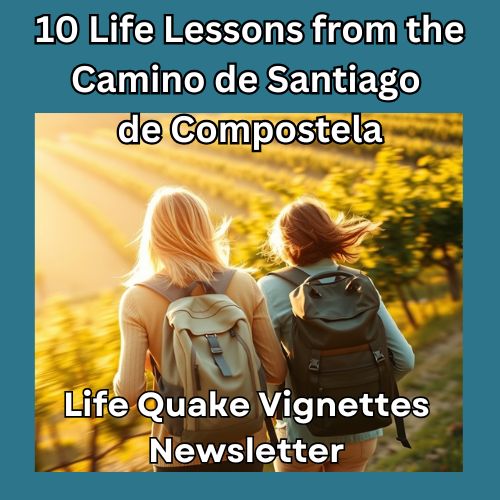
10 Powerful Life Lessons Learned While Walking the Camino de Santiago – a free guide filled with 10 not just “quaint anecdotes” or Instagram-worthy moments (though there are plenty of those) but real transformations from real people who walked the same insight-giving trail you might want to walk one day – Subscribe to my monthly newsletter to Download the Guide

“I am an experienced medical doctor – MBChB, MRCGP, NLP master pract cert, Transformational Life Coach (dip.) Life Story Coach (cert.) Stress Counselling (cert.) Med Hypnotherapy (dip.) and EAGALA (cert.) I may have an impressive number of letters after my name, and more than three decades of professional experience, but what qualifies me to excel at what I do is my intuitive understanding of my clients’ difficulties and my extensive personal experience of managing major life changes using strategies I developed over many years.” Dr M Montagu
All pictures of Toulouse are from Pixabay – many thanks to the photographers!

